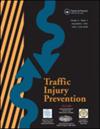Modeling drivers’ dilemma at unsignalized T-intersections under mixed traffic conditions: A case study from India
IF 1.6
3区 工程技术
Q3 PUBLIC, ENVIRONMENTAL & OCCUPATIONAL HEALTH
引用次数: 0
Abstract
Objective
At unsignalized T-intersections, right turning drivers from major or minor roads have to accept or reject the available gap and cross the intersection. Poor judgment may arise risk of collision with the major road conflicting vehicles. Subject drivers intending to cross the intersection encounter wide range of gaps. Drivers accept large gaps and reject small gaps. However, drivers experience dilemma over a wide range of gaps. This study aims to examine dilemma experienced by the right turning drivers by modeling gap acceptance and rejection decisions for estimating dilemma zone boundaries on major road.
Methods
Videographic method was considered for collecting traffic movement data at unsignalized T-intersections. Traffic video data was collected at three specific unsignalized T-intersections with varying degree of channelization. After this, accepted and rejected gaps with different traffic characteristics of offending vehicles (subject drivers) and conflicting vehicles such as speed, distance, vehicle type, etc. for right turning movements were extracted from the video data to analyze gap acceptance and rejection decisions of the drivers and estimate dilemma zone boundaries.
Results
Gap decisions (acceptance or rejection) were modeled using Generalized Linear Model (GLM) as a function of conflicting vehicle type, speed, and distance from the intersection along with degree of channelization for major and minor roads. The results showed that gap rejection probability increased with increment in conflicting vehicle’s speed and decrement in conflicting vehicle’s distance from the intersection. Dilemma zone boundaries were obtained using developed GLM models by estimating the conflicting vehicle distance from the intersection for 90% and 10% gap rejection probabilities. Dilemma zone boundaries were observed to shift farther from the intersection with increase in vehicle speed and vehicle size. The analysis revealed that subject drivers experienced more dilemma while accepting a gap from major road as compared to minor road.
Conclusions
This study showed that channelization plays a major role in mitigating dilemma of the subject drivers. Overall, the study identified dilemma zone boundaries for unsignalized T-intersections which may assist the right turning subject drivers to cross the intersection safely.
模拟混合交通条件下无信号灯 T 字路口司机的两难处境:印度案例研究。
目标:在没有信号灯的 T 型交叉路口,来自主干道或次干路的右转驾驶员必须接受或拒绝现有的空隙并通过交叉路口。判断失误可能导致与主干道冲突车辆发生碰撞的风险。打算通过交叉路口的驾驶员会遇到各种各样的空隙。驾驶员会接受大空隙,拒绝小空隙。然而,驾驶员会在广泛的空隙中进退两难。本研究旨在通过模拟接受和拒绝间隙的决策,研究右转弯驾驶员所经历的两难境地,从而估算出主要道路上的两难境地区域边界:方法:考虑在无信号灯的 T 字路口采用视频方法收集交通流数据。在三个特定的无信号 T 型路口收集了不同程度渠化的交通视频数据。然后,从视频数据中提取违规车辆(目标驾驶员)和冲突车辆在右转时的不同交通特征(如速度、距离、车辆类型等)所接受和拒绝的间隙,以分析驾驶员接受和拒绝间隙的决策,并估计两难区域的边界:使用广义线性模型(GLM)将空隙决策(接受或拒绝)作为冲突车辆类型、速度、与交叉口的距离以及主干道和次干道渠化程度的函数进行建模。结果表明,随着冲突车辆速度的增加和冲突车辆与交叉口距离的减小,空隙拒绝概率也随之增加。利用开发的 GLM 模型,通过估算冲突车辆与交叉口的距离,分别得出 90% 和 10% 的空隙拒绝概率,从而得出两难区域的边界。据观察,随着车速和车辆大小的增加,两难区域的边界会离交叉路口更远。分析表明,与小路相比,受试驾驶员在接受来自主干道的空隙时会遇到更多的困境:本研究表明,渠化在缓解受试驾驶员的困境方面发挥了重要作用。总之,该研究为无信号灯的 T 型交叉路口确定了两难区域的边界,这可能有助于右转的受试驾驶员安全通过交叉路口。
本文章由计算机程序翻译,如有差异,请以英文原文为准。
求助全文
约1分钟内获得全文
求助全文
来源期刊

Traffic Injury Prevention
PUBLIC, ENVIRONMENTAL & OCCUPATIONAL HEALTH-
CiteScore
3.60
自引率
10.00%
发文量
137
审稿时长
3 months
期刊介绍:
The purpose of Traffic Injury Prevention is to bridge the disciplines of medicine, engineering, public health and traffic safety in order to foster the science of traffic injury prevention. The archival journal focuses on research, interventions and evaluations within the areas of traffic safety, crash causation, injury prevention and treatment.
General topics within the journal''s scope are driver behavior, road infrastructure, emerging crash avoidance technologies, crash and injury epidemiology, alcohol and drugs, impact injury biomechanics, vehicle crashworthiness, occupant restraints, pedestrian safety, evaluation of interventions, economic consequences and emergency and clinical care with specific application to traffic injury prevention. The journal includes full length papers, review articles, case studies, brief technical notes and commentaries.
 求助内容:
求助内容: 应助结果提醒方式:
应助结果提醒方式:


